Inclusive Practice: Addressing Psychosocial Disability in NSW
VerifiedAdded on 2023/03/20
|11
|3207
|63
Report
AI Summary
This report focuses on inclusive practices for individuals with psychosocial disabilities, addressing the need for community integration and support. It begins by defining psychosocial disability and highlighting its prevalence in Australia, emphasizing the social barriers faced by affected individuals. The report proposes a project to identify and address these barriers, targeting individuals aged 0-50 in New South Wales. The project aims to conduct research, provide awareness and assistance therapies, and improve access to healthcare services. Activities include surveys, information dissemination, and therapy provision. The report outlines a six-month timeline, anticipates surveying a large population, and details the involvement of key organizations like the Australian Bureau of Statistics and Mental Health Australia. It emphasizes the principles of effective practice in disability and inclusion, and the importance of feedback mechanisms to improve service delivery. The project's ultimate goal is to enhance the quality of life and social participation of individuals with psychosocial disabilities, promoting their inclusion in mainstream society.
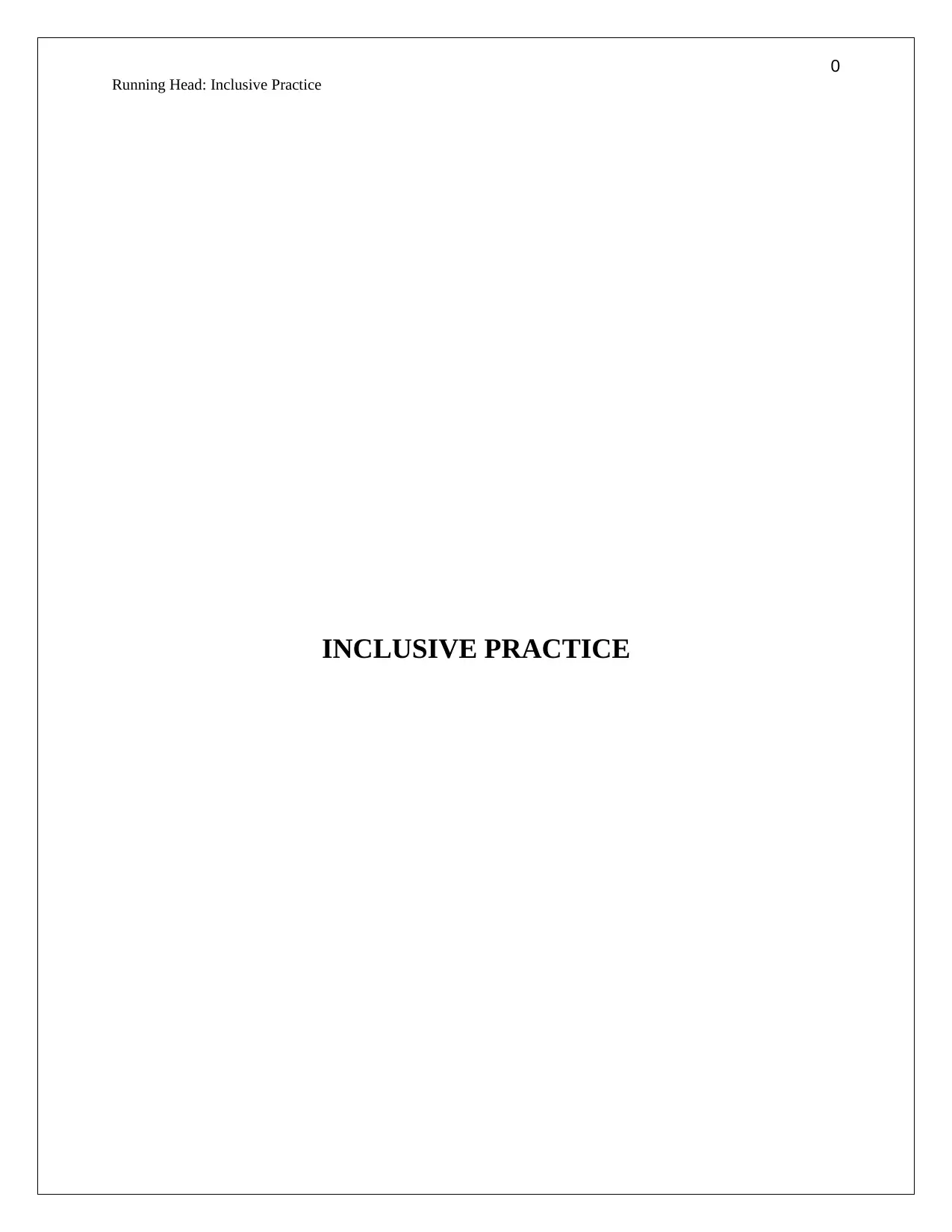
0
Running Head: Inclusive Practice
INCLUSIVE PRACTICE
Running Head: Inclusive Practice
INCLUSIVE PRACTICE
Paraphrase This Document
Need a fresh take? Get an instant paraphrase of this document with our AI Paraphraser

1
Inclusive Practice
Table of Contents
Identifying the need.........................................................................................................................2
Description of the social problem....................................................................................................2
Evidence of the problem..................................................................................................................2
Target group.....................................................................................................................................3
Scope for the activity.......................................................................................................................4
The response....................................................................................................................................4
Activities offered.............................................................................................................................4
Timeline...........................................................................................................................................5
Anticipated number of people.........................................................................................................5
Participating organisation................................................................................................................5
ILC focus areas................................................................................................................................6
Principles of effective practice in disability and inclusion..............................................................6
Reflection on contemporary understandings of inclusion...............................................................7
Information from the views.............................................................................................................7
The result.........................................................................................................................................7
ILC outcomes...................................................................................................................................7
Groups experiencing the outcomes..................................................................................................8
Reference List..................................................................................................................................9
Inclusive Practice
Table of Contents
Identifying the need.........................................................................................................................2
Description of the social problem....................................................................................................2
Evidence of the problem..................................................................................................................2
Target group.....................................................................................................................................3
Scope for the activity.......................................................................................................................4
The response....................................................................................................................................4
Activities offered.............................................................................................................................4
Timeline...........................................................................................................................................5
Anticipated number of people.........................................................................................................5
Participating organisation................................................................................................................5
ILC focus areas................................................................................................................................6
Principles of effective practice in disability and inclusion..............................................................6
Reflection on contemporary understandings of inclusion...............................................................7
Information from the views.............................................................................................................7
The result.........................................................................................................................................7
ILC outcomes...................................................................................................................................7
Groups experiencing the outcomes..................................................................................................8
Reference List..................................................................................................................................9
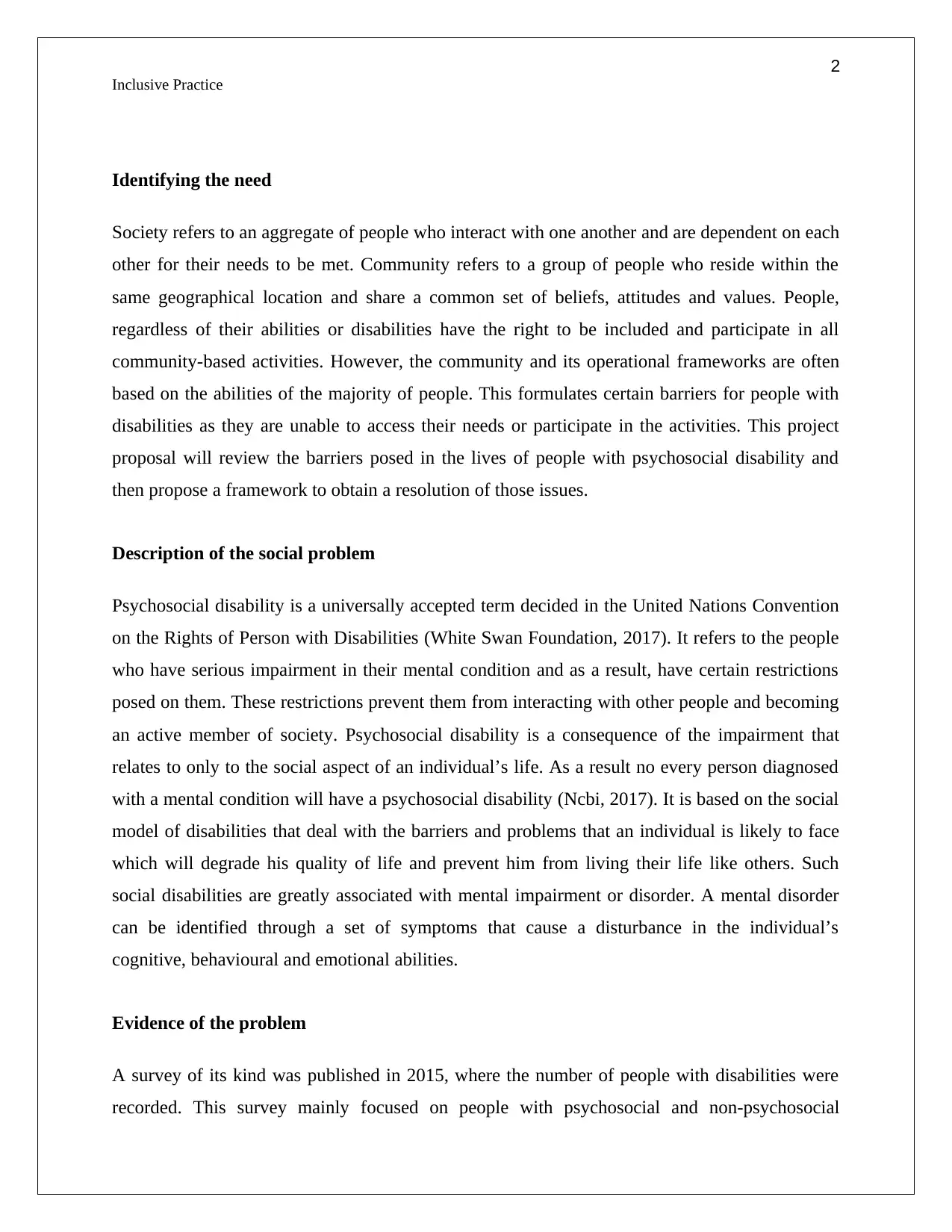
2
Inclusive Practice
Identifying the need
Society refers to an aggregate of people who interact with one another and are dependent on each
other for their needs to be met. Community refers to a group of people who reside within the
same geographical location and share a common set of beliefs, attitudes and values. People,
regardless of their abilities or disabilities have the right to be included and participate in all
community-based activities. However, the community and its operational frameworks are often
based on the abilities of the majority of people. This formulates certain barriers for people with
disabilities as they are unable to access their needs or participate in the activities. This project
proposal will review the barriers posed in the lives of people with psychosocial disability and
then propose a framework to obtain a resolution of those issues.
Description of the social problem
Psychosocial disability is a universally accepted term decided in the United Nations Convention
on the Rights of Person with Disabilities (White Swan Foundation, 2017). It refers to the people
who have serious impairment in their mental condition and as a result, have certain restrictions
posed on them. These restrictions prevent them from interacting with other people and becoming
an active member of society. Psychosocial disability is a consequence of the impairment that
relates to only to the social aspect of an individual’s life. As a result no every person diagnosed
with a mental condition will have a psychosocial disability (Ncbi, 2017). It is based on the social
model of disabilities that deal with the barriers and problems that an individual is likely to face
which will degrade his quality of life and prevent him from living their life like others. Such
social disabilities are greatly associated with mental impairment or disorder. A mental disorder
can be identified through a set of symptoms that cause a disturbance in the individual’s
cognitive, behavioural and emotional abilities.
Evidence of the problem
A survey of its kind was published in 2015, where the number of people with disabilities were
recorded. This survey mainly focused on people with psychosocial and non-psychosocial
Inclusive Practice
Identifying the need
Society refers to an aggregate of people who interact with one another and are dependent on each
other for their needs to be met. Community refers to a group of people who reside within the
same geographical location and share a common set of beliefs, attitudes and values. People,
regardless of their abilities or disabilities have the right to be included and participate in all
community-based activities. However, the community and its operational frameworks are often
based on the abilities of the majority of people. This formulates certain barriers for people with
disabilities as they are unable to access their needs or participate in the activities. This project
proposal will review the barriers posed in the lives of people with psychosocial disability and
then propose a framework to obtain a resolution of those issues.
Description of the social problem
Psychosocial disability is a universally accepted term decided in the United Nations Convention
on the Rights of Person with Disabilities (White Swan Foundation, 2017). It refers to the people
who have serious impairment in their mental condition and as a result, have certain restrictions
posed on them. These restrictions prevent them from interacting with other people and becoming
an active member of society. Psychosocial disability is a consequence of the impairment that
relates to only to the social aspect of an individual’s life. As a result no every person diagnosed
with a mental condition will have a psychosocial disability (Ncbi, 2017). It is based on the social
model of disabilities that deal with the barriers and problems that an individual is likely to face
which will degrade his quality of life and prevent him from living their life like others. Such
social disabilities are greatly associated with mental impairment or disorder. A mental disorder
can be identified through a set of symptoms that cause a disturbance in the individual’s
cognitive, behavioural and emotional abilities.
Evidence of the problem
A survey of its kind was published in 2015, where the number of people with disabilities were
recorded. This survey mainly focused on people with psychosocial and non-psychosocial
⊘ This is a preview!⊘
Do you want full access?
Subscribe today to unlock all pages.

Trusted by 1+ million students worldwide
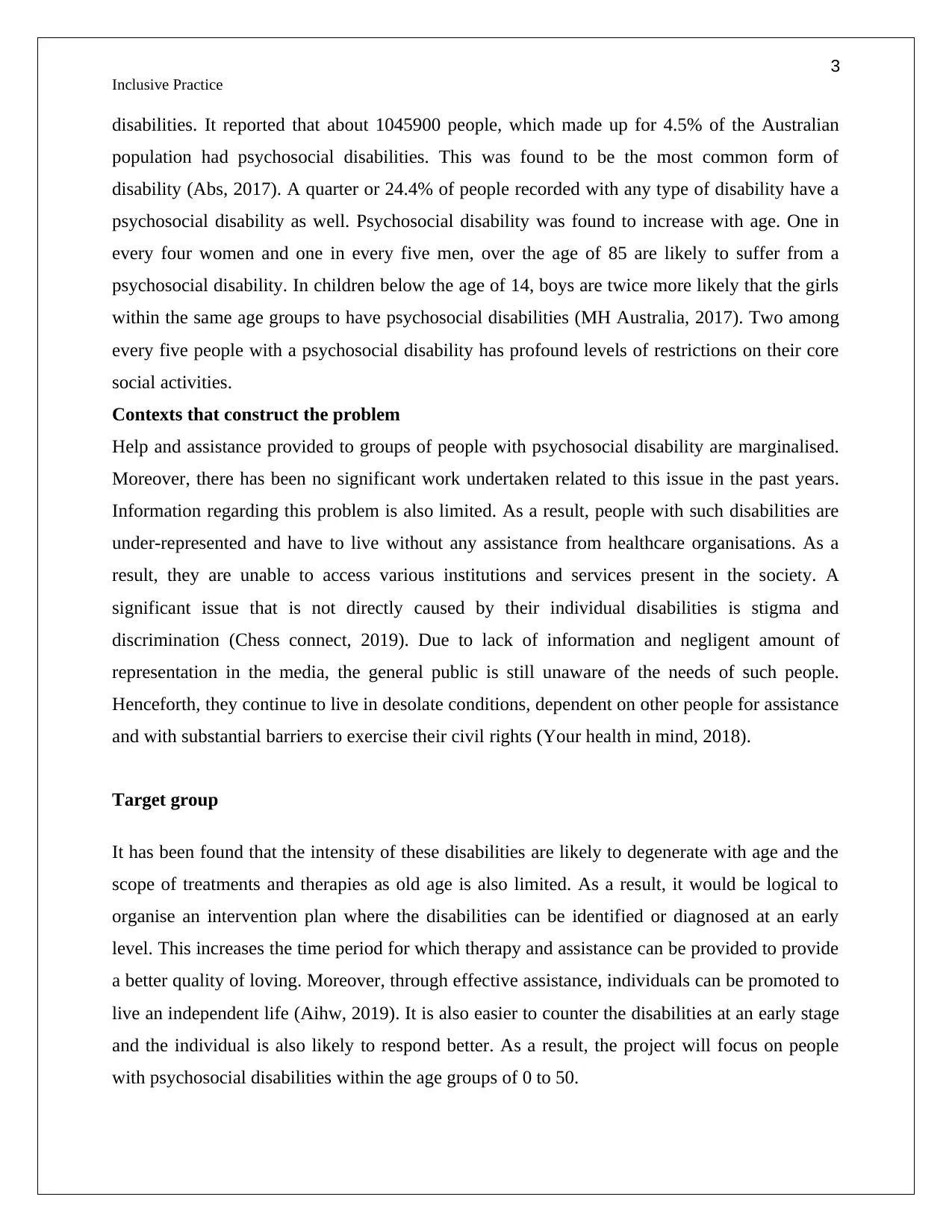
3
Inclusive Practice
disabilities. It reported that about 1045900 people, which made up for 4.5% of the Australian
population had psychosocial disabilities. This was found to be the most common form of
disability (Abs, 2017). A quarter or 24.4% of people recorded with any type of disability have a
psychosocial disability as well. Psychosocial disability was found to increase with age. One in
every four women and one in every five men, over the age of 85 are likely to suffer from a
psychosocial disability. In children below the age of 14, boys are twice more likely that the girls
within the same age groups to have psychosocial disabilities (MH Australia, 2017). Two among
every five people with a psychosocial disability has profound levels of restrictions on their core
social activities.
Contexts that construct the problem
Help and assistance provided to groups of people with psychosocial disability are marginalised.
Moreover, there has been no significant work undertaken related to this issue in the past years.
Information regarding this problem is also limited. As a result, people with such disabilities are
under-represented and have to live without any assistance from healthcare organisations. As a
result, they are unable to access various institutions and services present in the society. A
significant issue that is not directly caused by their individual disabilities is stigma and
discrimination (Chess connect, 2019). Due to lack of information and negligent amount of
representation in the media, the general public is still unaware of the needs of such people.
Henceforth, they continue to live in desolate conditions, dependent on other people for assistance
and with substantial barriers to exercise their civil rights (Your health in mind, 2018).
Target group
It has been found that the intensity of these disabilities are likely to degenerate with age and the
scope of treatments and therapies as old age is also limited. As a result, it would be logical to
organise an intervention plan where the disabilities can be identified or diagnosed at an early
level. This increases the time period for which therapy and assistance can be provided to provide
a better quality of loving. Moreover, through effective assistance, individuals can be promoted to
live an independent life (Aihw, 2019). It is also easier to counter the disabilities at an early stage
and the individual is also likely to respond better. As a result, the project will focus on people
with psychosocial disabilities within the age groups of 0 to 50.
Inclusive Practice
disabilities. It reported that about 1045900 people, which made up for 4.5% of the Australian
population had psychosocial disabilities. This was found to be the most common form of
disability (Abs, 2017). A quarter or 24.4% of people recorded with any type of disability have a
psychosocial disability as well. Psychosocial disability was found to increase with age. One in
every four women and one in every five men, over the age of 85 are likely to suffer from a
psychosocial disability. In children below the age of 14, boys are twice more likely that the girls
within the same age groups to have psychosocial disabilities (MH Australia, 2017). Two among
every five people with a psychosocial disability has profound levels of restrictions on their core
social activities.
Contexts that construct the problem
Help and assistance provided to groups of people with psychosocial disability are marginalised.
Moreover, there has been no significant work undertaken related to this issue in the past years.
Information regarding this problem is also limited. As a result, people with such disabilities are
under-represented and have to live without any assistance from healthcare organisations. As a
result, they are unable to access various institutions and services present in the society. A
significant issue that is not directly caused by their individual disabilities is stigma and
discrimination (Chess connect, 2019). Due to lack of information and negligent amount of
representation in the media, the general public is still unaware of the needs of such people.
Henceforth, they continue to live in desolate conditions, dependent on other people for assistance
and with substantial barriers to exercise their civil rights (Your health in mind, 2018).
Target group
It has been found that the intensity of these disabilities are likely to degenerate with age and the
scope of treatments and therapies as old age is also limited. As a result, it would be logical to
organise an intervention plan where the disabilities can be identified or diagnosed at an early
level. This increases the time period for which therapy and assistance can be provided to provide
a better quality of loving. Moreover, through effective assistance, individuals can be promoted to
live an independent life (Aihw, 2019). It is also easier to counter the disabilities at an early stage
and the individual is also likely to respond better. As a result, the project will focus on people
with psychosocial disabilities within the age groups of 0 to 50.
Paraphrase This Document
Need a fresh take? Get an instant paraphrase of this document with our AI Paraphraser

4
Inclusive Practice
Scope for the activity
● The activity will aim to conduct researches for better identifications and representations
of this community.
● Review how people with psychosocial disabilities view inclusion in society and grade
their quality of life.
● It will then go on to focus upon identified people and provide awareness and assistance
therapies to them.
● Enhance the range and availability of help provided by the existing healthcare
organisation.
The response
Activities offered
● Review the existing range of information and provide them to people with psychosocial
disabilities and their personal care providers.
● Conduct a survey to get greater insight into the number of people with psychosocial
disability and its nature.
● Provide information about the definition of quality of life as set by WHO and assess the
quality of life of affected people.
● Aim towards better and early diagnosis of people with a mental impairment to provide
medication and treatment from an early stage.
● Provide information about the range of therapies available for relieving the specified
disabilities
● Improving the availability and accessibility of such services provided by healthcare
organisations.
● Assessing the level of social inclusion and enhancement in the quality of life of
individuals after undergoing therapies and self-management practices.
● Using the achieved results to maximise the effectiveness of the therapies for targeted
people.
Inclusive Practice
Scope for the activity
● The activity will aim to conduct researches for better identifications and representations
of this community.
● Review how people with psychosocial disabilities view inclusion in society and grade
their quality of life.
● It will then go on to focus upon identified people and provide awareness and assistance
therapies to them.
● Enhance the range and availability of help provided by the existing healthcare
organisation.
The response
Activities offered
● Review the existing range of information and provide them to people with psychosocial
disabilities and their personal care providers.
● Conduct a survey to get greater insight into the number of people with psychosocial
disability and its nature.
● Provide information about the definition of quality of life as set by WHO and assess the
quality of life of affected people.
● Aim towards better and early diagnosis of people with a mental impairment to provide
medication and treatment from an early stage.
● Provide information about the range of therapies available for relieving the specified
disabilities
● Improving the availability and accessibility of such services provided by healthcare
organisations.
● Assessing the level of social inclusion and enhancement in the quality of life of
individuals after undergoing therapies and self-management practices.
● Using the achieved results to maximise the effectiveness of the therapies for targeted
people.
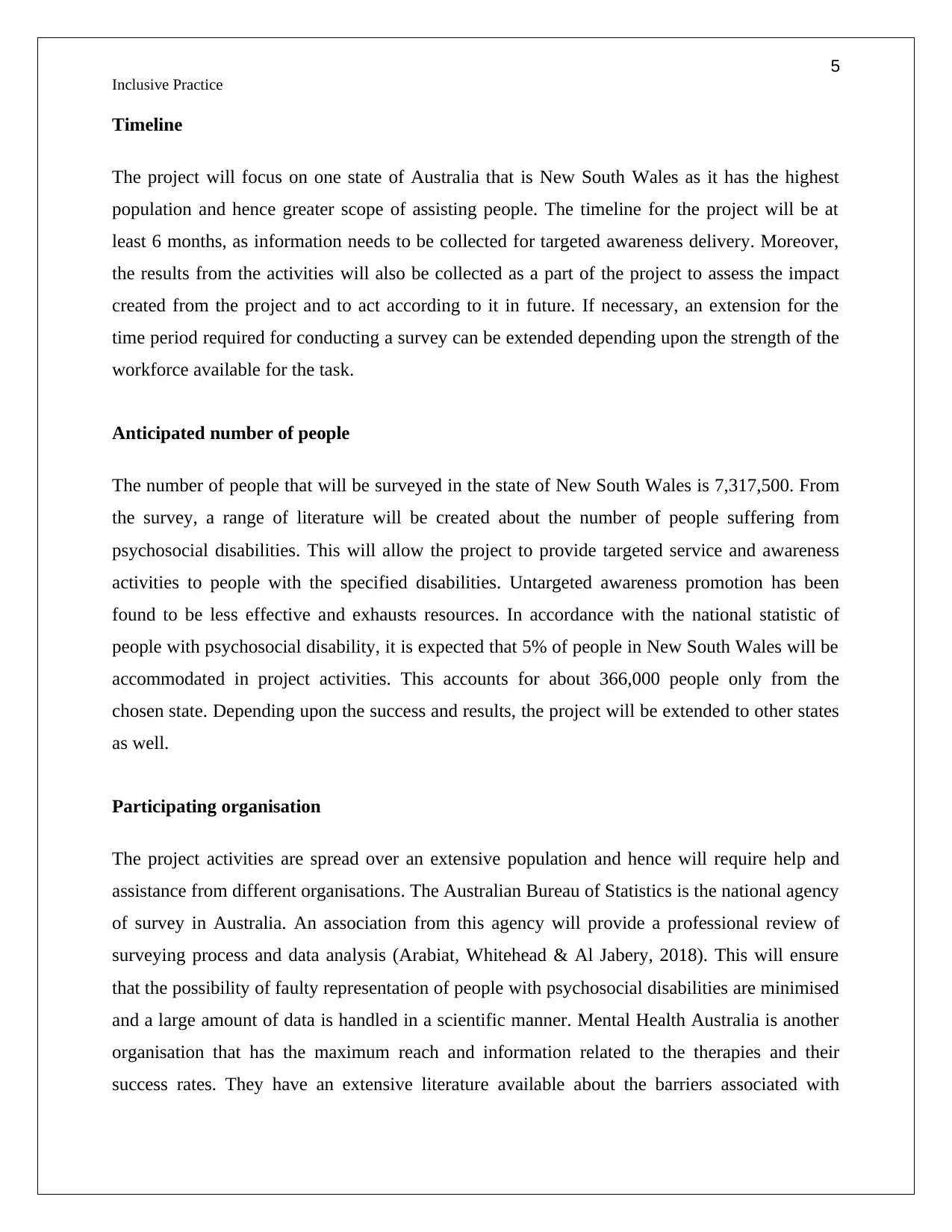
5
Inclusive Practice
Timeline
The project will focus on one state of Australia that is New South Wales as it has the highest
population and hence greater scope of assisting people. The timeline for the project will be at
least 6 months, as information needs to be collected for targeted awareness delivery. Moreover,
the results from the activities will also be collected as a part of the project to assess the impact
created from the project and to act according to it in future. If necessary, an extension for the
time period required for conducting a survey can be extended depending upon the strength of the
workforce available for the task.
Anticipated number of people
The number of people that will be surveyed in the state of New South Wales is 7,317,500. From
the survey, a range of literature will be created about the number of people suffering from
psychosocial disabilities. This will allow the project to provide targeted service and awareness
activities to people with the specified disabilities. Untargeted awareness promotion has been
found to be less effective and exhausts resources. In accordance with the national statistic of
people with psychosocial disability, it is expected that 5% of people in New South Wales will be
accommodated in project activities. This accounts for about 366,000 people only from the
chosen state. Depending upon the success and results, the project will be extended to other states
as well.
Participating organisation
The project activities are spread over an extensive population and hence will require help and
assistance from different organisations. The Australian Bureau of Statistics is the national agency
of survey in Australia. An association from this agency will provide a professional review of
surveying process and data analysis (Arabiat, Whitehead & Al Jabery, 2018). This will ensure
that the possibility of faulty representation of people with psychosocial disabilities are minimised
and a large amount of data is handled in a scientific manner. Mental Health Australia is another
organisation that has the maximum reach and information related to the therapies and their
success rates. They have an extensive literature available about the barriers associated with
Inclusive Practice
Timeline
The project will focus on one state of Australia that is New South Wales as it has the highest
population and hence greater scope of assisting people. The timeline for the project will be at
least 6 months, as information needs to be collected for targeted awareness delivery. Moreover,
the results from the activities will also be collected as a part of the project to assess the impact
created from the project and to act according to it in future. If necessary, an extension for the
time period required for conducting a survey can be extended depending upon the strength of the
workforce available for the task.
Anticipated number of people
The number of people that will be surveyed in the state of New South Wales is 7,317,500. From
the survey, a range of literature will be created about the number of people suffering from
psychosocial disabilities. This will allow the project to provide targeted service and awareness
activities to people with the specified disabilities. Untargeted awareness promotion has been
found to be less effective and exhausts resources. In accordance with the national statistic of
people with psychosocial disability, it is expected that 5% of people in New South Wales will be
accommodated in project activities. This accounts for about 366,000 people only from the
chosen state. Depending upon the success and results, the project will be extended to other states
as well.
Participating organisation
The project activities are spread over an extensive population and hence will require help and
assistance from different organisations. The Australian Bureau of Statistics is the national agency
of survey in Australia. An association from this agency will provide a professional review of
surveying process and data analysis (Arabiat, Whitehead & Al Jabery, 2018). This will ensure
that the possibility of faulty representation of people with psychosocial disabilities are minimised
and a large amount of data is handled in a scientific manner. Mental Health Australia is another
organisation that has the maximum reach and information related to the therapies and their
success rates. They have an extensive literature available about the barriers associated with
⊘ This is a preview!⊘
Do you want full access?
Subscribe today to unlock all pages.

Trusted by 1+ million students worldwide
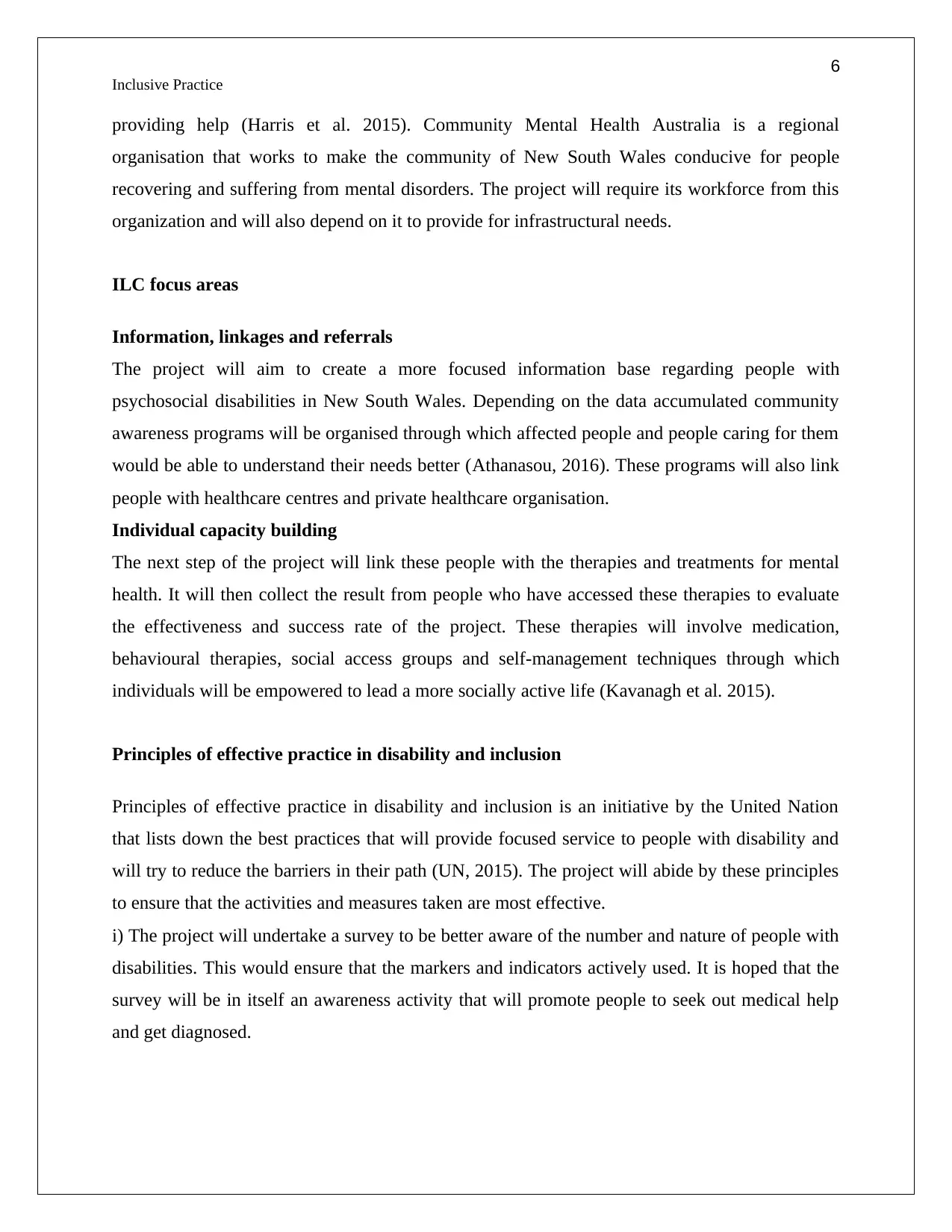
6
Inclusive Practice
providing help (Harris et al. 2015). Community Mental Health Australia is a regional
organisation that works to make the community of New South Wales conducive for people
recovering and suffering from mental disorders. The project will require its workforce from this
organization and will also depend on it to provide for infrastructural needs.
ILC focus areas
Information, linkages and referrals
The project will aim to create a more focused information base regarding people with
psychosocial disabilities in New South Wales. Depending on the data accumulated community
awareness programs will be organised through which affected people and people caring for them
would be able to understand their needs better (Athanasou, 2016). These programs will also link
people with healthcare centres and private healthcare organisation.
Individual capacity building
The next step of the project will link these people with the therapies and treatments for mental
health. It will then collect the result from people who have accessed these therapies to evaluate
the effectiveness and success rate of the project. These therapies will involve medication,
behavioural therapies, social access groups and self-management techniques through which
individuals will be empowered to lead a more socially active life (Kavanagh et al. 2015).
Principles of effective practice in disability and inclusion
Principles of effective practice in disability and inclusion is an initiative by the United Nation
that lists down the best practices that will provide focused service to people with disability and
will try to reduce the barriers in their path (UN, 2015). The project will abide by these principles
to ensure that the activities and measures taken are most effective.
i) The project will undertake a survey to be better aware of the number and nature of people with
disabilities. This would ensure that the markers and indicators actively used. It is hoped that the
survey will be in itself an awareness activity that will promote people to seek out medical help
and get diagnosed.
Inclusive Practice
providing help (Harris et al. 2015). Community Mental Health Australia is a regional
organisation that works to make the community of New South Wales conducive for people
recovering and suffering from mental disorders. The project will require its workforce from this
organization and will also depend on it to provide for infrastructural needs.
ILC focus areas
Information, linkages and referrals
The project will aim to create a more focused information base regarding people with
psychosocial disabilities in New South Wales. Depending on the data accumulated community
awareness programs will be organised through which affected people and people caring for them
would be able to understand their needs better (Athanasou, 2016). These programs will also link
people with healthcare centres and private healthcare organisation.
Individual capacity building
The next step of the project will link these people with the therapies and treatments for mental
health. It will then collect the result from people who have accessed these therapies to evaluate
the effectiveness and success rate of the project. These therapies will involve medication,
behavioural therapies, social access groups and self-management techniques through which
individuals will be empowered to lead a more socially active life (Kavanagh et al. 2015).
Principles of effective practice in disability and inclusion
Principles of effective practice in disability and inclusion is an initiative by the United Nation
that lists down the best practices that will provide focused service to people with disability and
will try to reduce the barriers in their path (UN, 2015). The project will abide by these principles
to ensure that the activities and measures taken are most effective.
i) The project will undertake a survey to be better aware of the number and nature of people with
disabilities. This would ensure that the markers and indicators actively used. It is hoped that the
survey will be in itself an awareness activity that will promote people to seek out medical help
and get diagnosed.
Paraphrase This Document
Need a fresh take? Get an instant paraphrase of this document with our AI Paraphraser
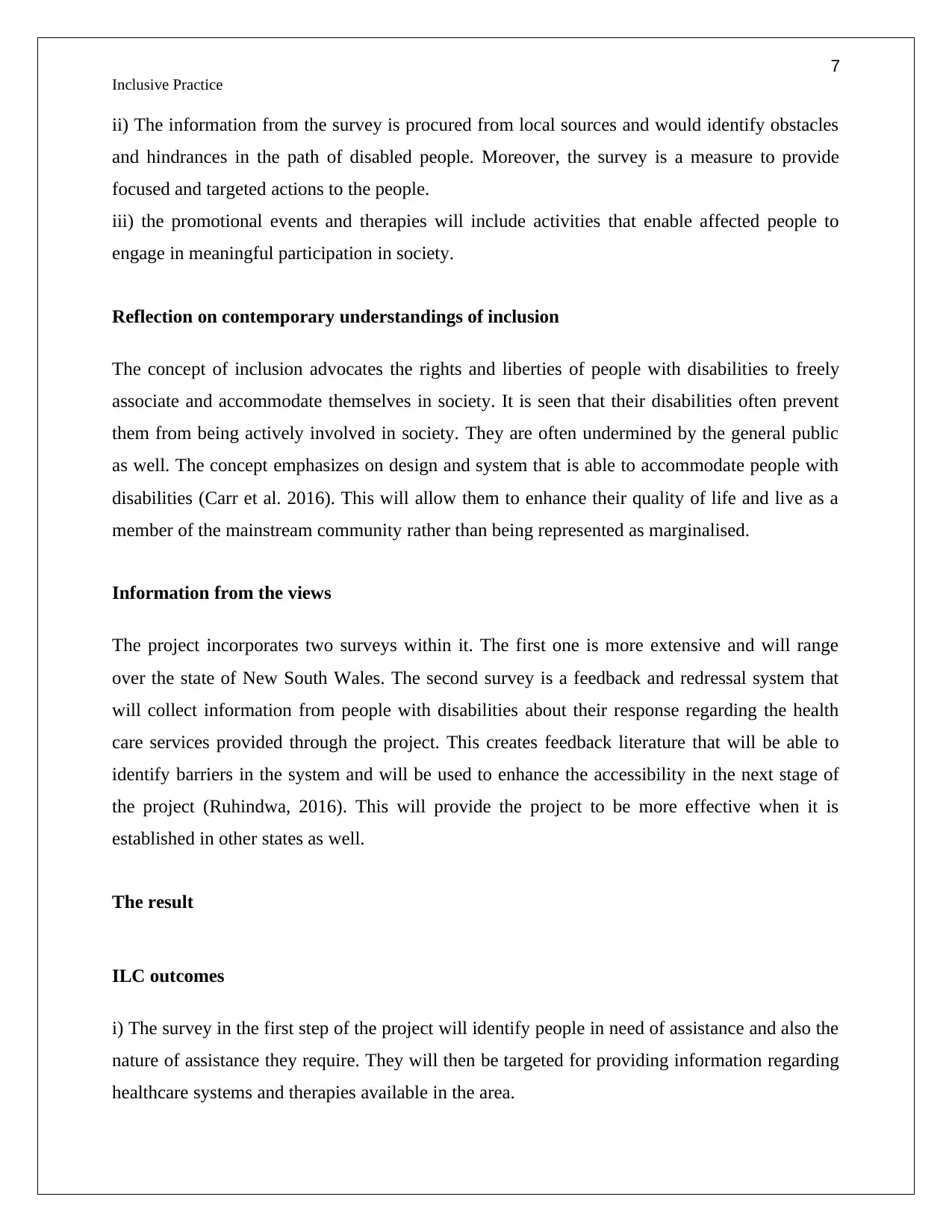
7
Inclusive Practice
ii) The information from the survey is procured from local sources and would identify obstacles
and hindrances in the path of disabled people. Moreover, the survey is a measure to provide
focused and targeted actions to the people.
iii) the promotional events and therapies will include activities that enable affected people to
engage in meaningful participation in society.
Reflection on contemporary understandings of inclusion
The concept of inclusion advocates the rights and liberties of people with disabilities to freely
associate and accommodate themselves in society. It is seen that their disabilities often prevent
them from being actively involved in society. They are often undermined by the general public
as well. The concept emphasizes on design and system that is able to accommodate people with
disabilities (Carr et al. 2016). This will allow them to enhance their quality of life and live as a
member of the mainstream community rather than being represented as marginalised.
Information from the views
The project incorporates two surveys within it. The first one is more extensive and will range
over the state of New South Wales. The second survey is a feedback and redressal system that
will collect information from people with disabilities about their response regarding the health
care services provided through the project. This creates feedback literature that will be able to
identify barriers in the system and will be used to enhance the accessibility in the next stage of
the project (Ruhindwa, 2016). This will provide the project to be more effective when it is
established in other states as well.
The result
ILC outcomes
i) The survey in the first step of the project will identify people in need of assistance and also the
nature of assistance they require. They will then be targeted for providing information regarding
healthcare systems and therapies available in the area.
Inclusive Practice
ii) The information from the survey is procured from local sources and would identify obstacles
and hindrances in the path of disabled people. Moreover, the survey is a measure to provide
focused and targeted actions to the people.
iii) the promotional events and therapies will include activities that enable affected people to
engage in meaningful participation in society.
Reflection on contemporary understandings of inclusion
The concept of inclusion advocates the rights and liberties of people with disabilities to freely
associate and accommodate themselves in society. It is seen that their disabilities often prevent
them from being actively involved in society. They are often undermined by the general public
as well. The concept emphasizes on design and system that is able to accommodate people with
disabilities (Carr et al. 2016). This will allow them to enhance their quality of life and live as a
member of the mainstream community rather than being represented as marginalised.
Information from the views
The project incorporates two surveys within it. The first one is more extensive and will range
over the state of New South Wales. The second survey is a feedback and redressal system that
will collect information from people with disabilities about their response regarding the health
care services provided through the project. This creates feedback literature that will be able to
identify barriers in the system and will be used to enhance the accessibility in the next stage of
the project (Ruhindwa, 2016). This will provide the project to be more effective when it is
established in other states as well.
The result
ILC outcomes
i) The survey in the first step of the project will identify people in need of assistance and also the
nature of assistance they require. They will then be targeted for providing information regarding
healthcare systems and therapies available in the area.
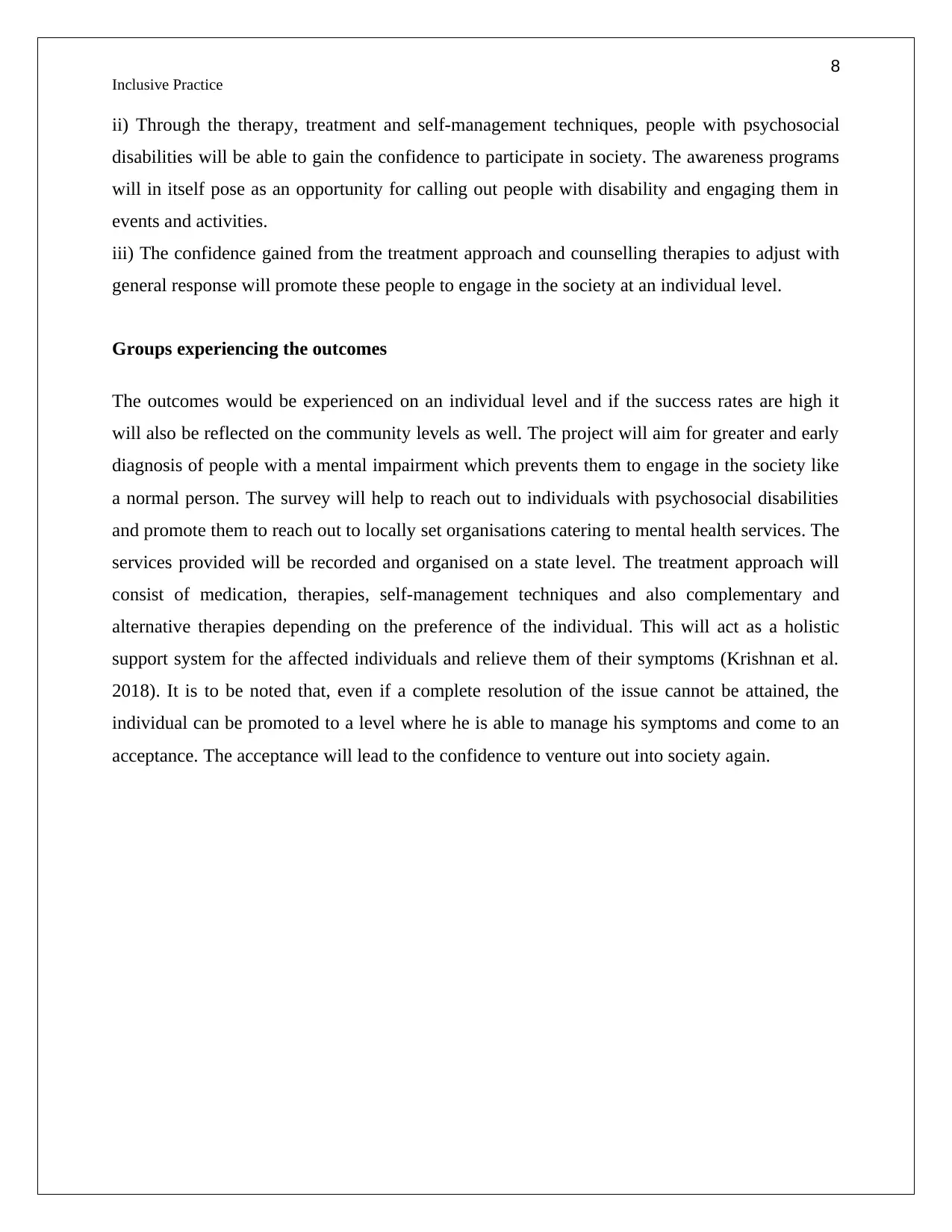
8
Inclusive Practice
ii) Through the therapy, treatment and self-management techniques, people with psychosocial
disabilities will be able to gain the confidence to participate in society. The awareness programs
will in itself pose as an opportunity for calling out people with disability and engaging them in
events and activities.
iii) The confidence gained from the treatment approach and counselling therapies to adjust with
general response will promote these people to engage in the society at an individual level.
Groups experiencing the outcomes
The outcomes would be experienced on an individual level and if the success rates are high it
will also be reflected on the community levels as well. The project will aim for greater and early
diagnosis of people with a mental impairment which prevents them to engage in the society like
a normal person. The survey will help to reach out to individuals with psychosocial disabilities
and promote them to reach out to locally set organisations catering to mental health services. The
services provided will be recorded and organised on a state level. The treatment approach will
consist of medication, therapies, self-management techniques and also complementary and
alternative therapies depending on the preference of the individual. This will act as a holistic
support system for the affected individuals and relieve them of their symptoms (Krishnan et al.
2018). It is to be noted that, even if a complete resolution of the issue cannot be attained, the
individual can be promoted to a level where he is able to manage his symptoms and come to an
acceptance. The acceptance will lead to the confidence to venture out into society again.
Inclusive Practice
ii) Through the therapy, treatment and self-management techniques, people with psychosocial
disabilities will be able to gain the confidence to participate in society. The awareness programs
will in itself pose as an opportunity for calling out people with disability and engaging them in
events and activities.
iii) The confidence gained from the treatment approach and counselling therapies to adjust with
general response will promote these people to engage in the society at an individual level.
Groups experiencing the outcomes
The outcomes would be experienced on an individual level and if the success rates are high it
will also be reflected on the community levels as well. The project will aim for greater and early
diagnosis of people with a mental impairment which prevents them to engage in the society like
a normal person. The survey will help to reach out to individuals with psychosocial disabilities
and promote them to reach out to locally set organisations catering to mental health services. The
services provided will be recorded and organised on a state level. The treatment approach will
consist of medication, therapies, self-management techniques and also complementary and
alternative therapies depending on the preference of the individual. This will act as a holistic
support system for the affected individuals and relieve them of their symptoms (Krishnan et al.
2018). It is to be noted that, even if a complete resolution of the issue cannot be attained, the
individual can be promoted to a level where he is able to manage his symptoms and come to an
acceptance. The acceptance will lead to the confidence to venture out into society again.
⊘ This is a preview!⊘
Do you want full access?
Subscribe today to unlock all pages.

Trusted by 1+ million students worldwide
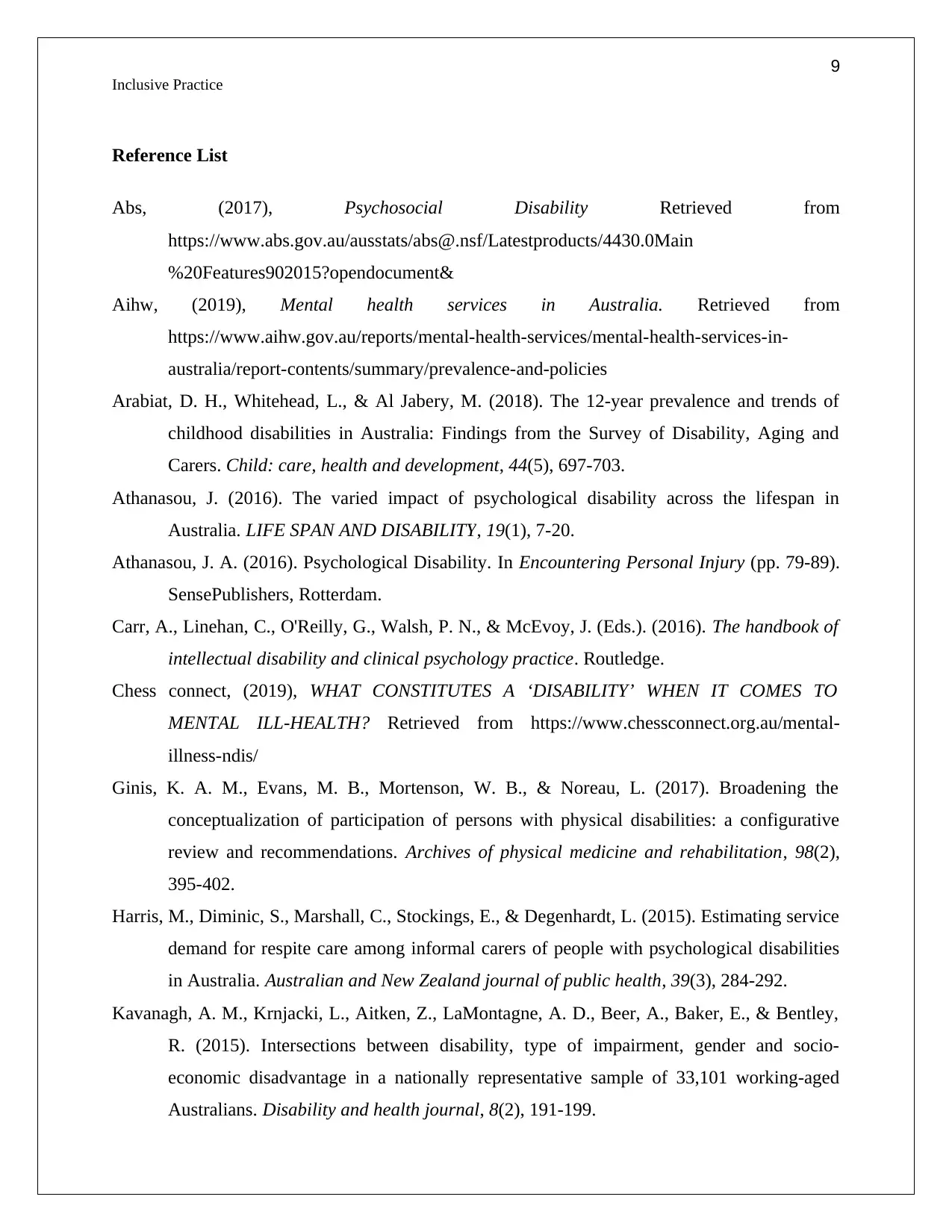
9
Inclusive Practice
Reference List
Abs, (2017), Psychosocial Disability Retrieved from
https://www.abs.gov.au/ausstats/abs@.nsf/Latestproducts/4430.0Main
%20Features902015?opendocument&
Aihw, (2019), Mental health services in Australia. Retrieved from
https://www.aihw.gov.au/reports/mental-health-services/mental-health-services-in-
australia/report-contents/summary/prevalence-and-policies
Arabiat, D. H., Whitehead, L., & Al Jabery, M. (2018). The 12‐year prevalence and trends of
childhood disabilities in Australia: Findings from the Survey of Disability, Aging and
Carers. Child: care, health and development, 44(5), 697-703.
Athanasou, J. (2016). The varied impact of psychological disability across the lifespan in
Australia. LIFE SPAN AND DISABILITY, 19(1), 7-20.
Athanasou, J. A. (2016). Psychological Disability. In Encountering Personal Injury (pp. 79-89).
SensePublishers, Rotterdam.
Carr, A., Linehan, C., O'Reilly, G., Walsh, P. N., & McEvoy, J. (Eds.). (2016). The handbook of
intellectual disability and clinical psychology practice. Routledge.
Chess connect, (2019), WHAT CONSTITUTES A ‘DISABILITY’ WHEN IT COMES TO
MENTAL ILL-HEALTH? Retrieved from https://www.chessconnect.org.au/mental-
illness-ndis/
Ginis, K. A. M., Evans, M. B., Mortenson, W. B., & Noreau, L. (2017). Broadening the
conceptualization of participation of persons with physical disabilities: a configurative
review and recommendations. Archives of physical medicine and rehabilitation, 98(2),
395-402.
Harris, M., Diminic, S., Marshall, C., Stockings, E., & Degenhardt, L. (2015). Estimating service
demand for respite care among informal carers of people with psychological disabilities
in Australia. Australian and New Zealand journal of public health, 39(3), 284-292.
Kavanagh, A. M., Krnjacki, L., Aitken, Z., LaMontagne, A. D., Beer, A., Baker, E., & Bentley,
R. (2015). Intersections between disability, type of impairment, gender and socio-
economic disadvantage in a nationally representative sample of 33,101 working-aged
Australians. Disability and health journal, 8(2), 191-199.
Inclusive Practice
Reference List
Abs, (2017), Psychosocial Disability Retrieved from
https://www.abs.gov.au/ausstats/abs@.nsf/Latestproducts/4430.0Main
%20Features902015?opendocument&
Aihw, (2019), Mental health services in Australia. Retrieved from
https://www.aihw.gov.au/reports/mental-health-services/mental-health-services-in-
australia/report-contents/summary/prevalence-and-policies
Arabiat, D. H., Whitehead, L., & Al Jabery, M. (2018). The 12‐year prevalence and trends of
childhood disabilities in Australia: Findings from the Survey of Disability, Aging and
Carers. Child: care, health and development, 44(5), 697-703.
Athanasou, J. (2016). The varied impact of psychological disability across the lifespan in
Australia. LIFE SPAN AND DISABILITY, 19(1), 7-20.
Athanasou, J. A. (2016). Psychological Disability. In Encountering Personal Injury (pp. 79-89).
SensePublishers, Rotterdam.
Carr, A., Linehan, C., O'Reilly, G., Walsh, P. N., & McEvoy, J. (Eds.). (2016). The handbook of
intellectual disability and clinical psychology practice. Routledge.
Chess connect, (2019), WHAT CONSTITUTES A ‘DISABILITY’ WHEN IT COMES TO
MENTAL ILL-HEALTH? Retrieved from https://www.chessconnect.org.au/mental-
illness-ndis/
Ginis, K. A. M., Evans, M. B., Mortenson, W. B., & Noreau, L. (2017). Broadening the
conceptualization of participation of persons with physical disabilities: a configurative
review and recommendations. Archives of physical medicine and rehabilitation, 98(2),
395-402.
Harris, M., Diminic, S., Marshall, C., Stockings, E., & Degenhardt, L. (2015). Estimating service
demand for respite care among informal carers of people with psychological disabilities
in Australia. Australian and New Zealand journal of public health, 39(3), 284-292.
Kavanagh, A. M., Krnjacki, L., Aitken, Z., LaMontagne, A. D., Beer, A., Baker, E., & Bentley,
R. (2015). Intersections between disability, type of impairment, gender and socio-
economic disadvantage in a nationally representative sample of 33,101 working-aged
Australians. Disability and health journal, 8(2), 191-199.
Paraphrase This Document
Need a fresh take? Get an instant paraphrase of this document with our AI Paraphraser

10
Inclusive Practice
Krishnan, R., Ram, D., Hridya, V. M., & Santhosh, A. J. (2018). Effectiveness of
Psychoeducation on Psychological Wellbeing and Self-Determination in Key Caregivers
of Children with Intellectual Disability. Indian Journal of Psychiatric Social Work, 9(1),
4-11.
MH Australia, (2017), Optimising support for Psychosocials Disability, Retrieved from
https://mhaustralia.org/optimising-support-for-psychosocial-disability
Ncbi, (2017), Psychosocial issues within primary health care settings: challenges and
opportunities for social work practice. Retrieved from
https://www.ncbi.nlm.nih.gov/pubmed/14984249
Ruhindwa, A. (2016). Exploring the challenges experienced by people with disabilities in the
employment sector in Australia: Advocating for inclusive practice-a review of literature.
Journal of Social Inclusion, 7(1), 4-19.
Taheri, A., Perry, A., & Minnes, P. (2016). Examining the social participation of children and
adolescents with Intellectual Disabilities and Autism Spectrum Disorder in relation to
peers. Journal of Intellectual Disability Research, 60(5), 435-443.
UN, (2015), Best Practices for including persons with disabilities in all aspects of development
efforts. Retrieved from
https://www.un.org/disabilities/documents/best_practices_publication_2011.pdf
White Swan Foundation, (2017) What is psychosocial disability?. Retrieved from
https://www.whiteswanfoundation.org/article/what-is-a-psychosocial-disability/
Your health in mind, (2018), Psychological treatments. Retrieved from
https://www.yourhealthinmind.org/treatments-medication/psychological-treatments
Inclusive Practice
Krishnan, R., Ram, D., Hridya, V. M., & Santhosh, A. J. (2018). Effectiveness of
Psychoeducation on Psychological Wellbeing and Self-Determination in Key Caregivers
of Children with Intellectual Disability. Indian Journal of Psychiatric Social Work, 9(1),
4-11.
MH Australia, (2017), Optimising support for Psychosocials Disability, Retrieved from
https://mhaustralia.org/optimising-support-for-psychosocial-disability
Ncbi, (2017), Psychosocial issues within primary health care settings: challenges and
opportunities for social work practice. Retrieved from
https://www.ncbi.nlm.nih.gov/pubmed/14984249
Ruhindwa, A. (2016). Exploring the challenges experienced by people with disabilities in the
employment sector in Australia: Advocating for inclusive practice-a review of literature.
Journal of Social Inclusion, 7(1), 4-19.
Taheri, A., Perry, A., & Minnes, P. (2016). Examining the social participation of children and
adolescents with Intellectual Disabilities and Autism Spectrum Disorder in relation to
peers. Journal of Intellectual Disability Research, 60(5), 435-443.
UN, (2015), Best Practices for including persons with disabilities in all aspects of development
efforts. Retrieved from
https://www.un.org/disabilities/documents/best_practices_publication_2011.pdf
White Swan Foundation, (2017) What is psychosocial disability?. Retrieved from
https://www.whiteswanfoundation.org/article/what-is-a-psychosocial-disability/
Your health in mind, (2018), Psychological treatments. Retrieved from
https://www.yourhealthinmind.org/treatments-medication/psychological-treatments
1 out of 11
Related Documents
Your All-in-One AI-Powered Toolkit for Academic Success.
+13062052269
info@desklib.com
Available 24*7 on WhatsApp / Email
![[object Object]](/_next/static/media/star-bottom.7253800d.svg)
Unlock your academic potential
Copyright © 2020–2025 A2Z Services. All Rights Reserved. Developed and managed by ZUCOL.





